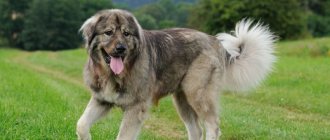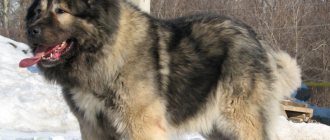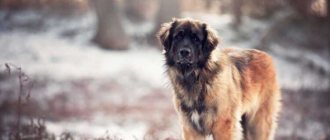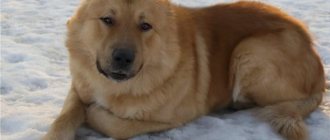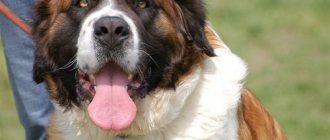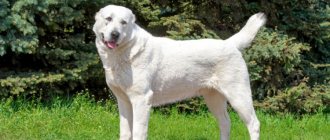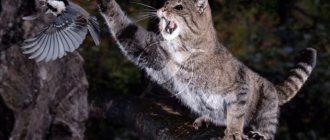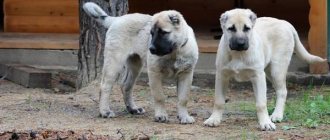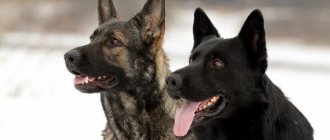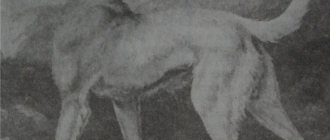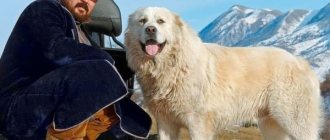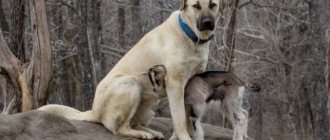The Caucasian Shepherd Dog is undoubtedly a distant descendant of the mastiff-like Tibetan Great Danes, although there is not enough material to reliably indicate all stages of formation.
It is only known that this aboriginal breed took root in the Caucasus more than 600 years ago.
For almost 1000 years, the duties of the KO included: guarding flocks and protecting human habitation from all types of predators on four or two legs, so it is difficult to suspect this breed of being friendly to strangers or animals.
History of the Caucasian Shepherd Dog breed
Caucasian Shepherd Dog
Caucasian Shepherd Dogs are among the oldest dog “clans”, the history of which dates back thousands of years. For example, the ancestors of today's wolfhounds grazed sheep flocks in the foothills of the Caucasus long before the advent of Christianity. As for the origin of the breed itself, its founders are considered to be the Tibetan Great Danes, which in Ancient China were used for baiting and fighting. Some experts call the homeland of dogs southwestern Asia, or more precisely, the Urartu-Ararat kingdom, where the animals were in the service of cattle breeders and from where they began to disperse across adjacent territories.
An interesting fact: the first “breeders” to whom Caucasian Shepherds owe their outstanding guard instinct were ancient shepherds. It was they who were in charge of breeding animals and selecting puppies, cultivating and successfully developing useful performance characteristics in them. For example, a real shepherd dog, in the understanding of Caucasian shepherds, had to have endurance and sufficient strength to deal with an attacking wolf. In addition, she was prescribed unpretentiousness in food and insensitivity to sudden changes in air temperature.
The impetus for the appearance of shaggy “highlanders” in tsarist Russia was the Caucasian War. Participants in the hostilities brought dogs as living trophies, but none of the newly minted shepherd dog owners had any desire to seriously engage in breeding the breed. Domestic breeders began to take an interest in wolfhounds only in the 30s of the last century, after the Nuremberg Exhibition, but their breeding research was interrupted by the Second World War, which destroyed the entire gene pool of Caucasians. It was possible to more or less restore the breed in the USSR only in the early 70s. Around this time, consumer demand for Caucasian Shepherds began to grow.
Interesting Facts
- The world's largest Caucasian Shepherd lives in Ukraine, in the city of Odessa. The pet's name is Grizzly, he weighs more than 100 kg;
- In 1933 I.V. Stalin signed a decree “On the development of domestic dog breeding”, as a result of which most of the Shepherd dog population was taken out of the Caucasus. In 1941, dogs were evacuated en masse after the start of the Great Patriotic War;
- Caucasian Shepherd Dogs were used to breed the Moscow Watchdog - mainly individuals taken from Azerbaijan were used;
- In the 30s of the twentieth century, a male named Topush, who killed more than a hundred wolves in his life, was recognized as the best working Shepherd Dog.
Appearance of the Caucasian Shepherd
What Caucasian Shepherd Dogs cannot be blamed for is the lack of charisma and external charm. Indeed, the muscular “highlanders” look very respectable, if not monumental. Long-haired individuals with lush, almost bear-like “fur coats” look especially colorful, giving the animals a resemblance to gigantic toys.
The minimum weight of a purebred male Caucasian wolfhound is 50 kg. However, most dogs do not stop at such modest figures, often breaking the bar of 70 and sometimes 100 kg. Shepherd females are shorter and slimmer than males: the minimum permissible weight for a girl is 45 kg, with a height of 64 cm. But, as with any rule, there are exceptions here too.
Head
Caucasian Shepherd puppies
Wedge-shaped, with a flat forehead and prominent cheekbones. The Caucasian Shepherd's skull looks massive, but the brow ridges and occipital protuberance of representatives of this breed are weakly expressed. The muzzle is wide, gradually tapers from the base to the nose and ends with a strong chin. The stop is noticeable, but without a sharp transition.
Lips
Dry, fleshy, with good pigmentation.
Teeth
Massive, white, incisors are located tightly to each other. Both scissor and straight bite types are acceptable. It is desirable to have a full set of teeth (42).
Nose
Caucasian Shepherd with a person
The bridge of the nose is smooth, wide, with a large lobe that does not extend beyond the muzzle. The nostrils are opened moderately. Ideally, the lobe should be black, but for individuals with piebald and spotted coat colors, an exception can be made.
Eyes
Caucasian Shepherds have round eyes, located slightly obliquely and at a fairly large distance from each other. Representatives of this breed have an attentive, focused, appraising gaze. The iris colors specified by the breed standard are all shades of brown, including dark brown and light hazel variants.
Ears
Small, hanging type and high set. The ear flap is densely muscular with the inner part pressed to the head. Both cropped and natural ear shapes are acceptable.
Neck
Short, dense, with a developed scruff.
Frame
The body of the Caucasian Shepherd is large, elongated, with a wide back, short loin and tucked belly. The croup is slightly rounded, elongated, with a slight slope at the base of the tail. The chest is deep and noticeably extended in breadth.
Muzzle of a Caucasian Shepherd dog
Tail
Crescent-shaped, set high. In a calm animal, it hangs down, reaching the hocks; in an excited animal, it is raised above the line of the back.
Limbs
The front and rear legs are placed level. Wide shoulder blades, pressed to the body, turn into strong, muscular shoulders. The pasterns are large and short. The hips of Caucasian Shepherds are strong and “pumped up”. The hock joints are dry, wide and strong. The paws of all four limbs are large, arched, with toes compressed into a ball.
Wool
Satisfied Caucasian man
Coarse hair, noticeably lagging behind the body, with a pronounced undercoat. The average length of the awn and undercoat is 5 cm. On the ears, the hair forms funny tassels, and in the chest area it turns into a chic mane. On the back of the front paws, the hair gathers into long feathers; the dog’s hips are hidden under soft downy “pants.” The tail is heavily covered with hair, making it appear thicker than it actually is. Depending on the length and structure of the coat, three types of Caucasian wolfhounds are distinguished:
- smooth-haired;
- long-haired;
- intermediate.
Among buyers, individuals of the second type are in high demand. Of the entire tribe of Caucasian Shepherd Dogs, they are the ones who have the most striking and memorable appearance. Representatives of the first variety are easily confused with Alabai due to their short undercoat and similar build.
Color
All types of piebald, solid and spotted colors are accepted, with the exception of any combination of black.
Possible defects
Caucasian Shepherd Dogs are considered defective if their anatomical features do not fit into the official standard. An animal may be disqualified from competition if it has the following developmental defects:
- cryptorchidism;
- lack of height (dwarfism);
- non-standard bite;
- brown-brown color and any variations thereof;
- blue and black coat colors, as well as any combinations thereof;
- docked tail;
- blue or grayish tint to the eyelids, earlobes and lips;
- entropy;
- eyes of different shades, as well as uneven color;
- absence of one or more teeth (exceptions: third molars and first premolars);
- brown tint to eyelids, lips and nose.
Intrabreed types of CR
Caucasian Shepherd dogs raised in different regions of the Caucasus differ in the type of constitution.
In Kabardino-Balkaria, the short-haired type of CO is still found, once obtained from matings of old Balkar Shepherd Dogs and Georgian Mountain Dogs. They were called Sarmatian Mastiffs and were highly valued for their watchdog qualities, self-confidence and absolute loyalty.
A significant number of strong and large dogs came to Iran and Turkey after Russian-Circassian clashes under the name of the Circassian mountain shepherd, where they mixed with local Turkish, Armenian and Georgian species.
In Turkey, they even bred their own separate version of the shepherd dogs of the Anatolian Plateau - the Anatolian Karabash (kangal) - the closest relative of the “Caucasian” and the Central Asian shepherd dog.
In Iran, the Caucasian Shepherd Dog again merges with the Central Asian one, forming a single transitional form, which has so far been little studied. This form concentrates the two largest branches of Tibetan Molossians - the Caucasian and Central Asian Shepherd Dogs.
Armenian dogs look smaller, have lighter bones, an elongated muzzle, a more compact body, but are not inferior to the “Georgians” in the beauty and length of the coat, which also has a uniform zonal gray, brown and dark fawn color - this is the first type of Gamprov - Caucasian Shepherd dogs bred in the Armenian Highlands. The second type is more bony and larger, and has short, smooth coat.
Caucasian Shepherd of Armenian type
Shepherd dogs of Azerbaijan are divided into 2 types:
- Mountain - close to Georgian, but smaller in size.
- Steppe is a strong and dry type of square format.
“Azerbaijanis” are characterized by fawn and red colors; spotted individuals with short hair are also found.
A large KO was bred in Dagestan, tall, athletic, with strong bones and a desirable head. However, its almost square format does not allow it to be called the standard of the Caucasian Shepherd Dog.
The coat and color are varied; there are dogs with long hair, medium-length hair and very short hair.
In 1930, the Georgian type was recognized as the standard for breeding - the largest Caucasian Shepherd of all available types, which compares favorably with the rest with a more massive skeleton with a slightly elongated body, large stature, and heavy weight.
The semi-long, straight, thick coat with a uniform (most often zone-gray or fawn) color also gives the Georgian type an external attractiveness. The expressiveness of the muzzle is emphasized by a dark mask.
Today Nagazi (as Georgians call their wolfhound) is no longer a standard, but it was he who laid the foundation for the factory cultivation of a magnificent breed - the Caucasian Shepherd Dog.
Along with the presence of intrabreed groups, there are also 7 narrow subgroups of CR. For example, such as Kurdish, Gorban, Kazbegi, etc.
It is difficult even for an experienced dog handler to immediately distinguish the type and subgroup of the shaggy giant, if he is not closely involved in this particular breed, but any of them knows that the North Caucasian Shepherd Dog (Salsk steppes, areas of the Rostov and Astrakhan regions, Stavropol and Krasnodar territories) in contrast to Transcaucasian, has a drier (but not light!) type of constitutional build with high legs, a shortened format index and a more elongated head shape.
Transcaucasia (the entire southern part of the Caucasus, located beyond the Greater Caucasus mountain range) continues to cultivate more squat, massive animals.
However, such a difference does not in any way affect the range of the main breed characteristics of the KO - enormous physical strength, supported by powerful muscles, excellent hearing, quick reaction, flexible mind, possessive attitude towards the owner and his property, which allows them to efficiently cope with the role of a shepherd and a watchman at the same time.
Photo of an adult Caucasian Shepherd dog
Personality of the Caucasian Shepherd
Having a rather pleasant and sometimes downright touching appearance, Caucasian wolfhounds remain very serious pets, the owners of which will have to constantly keep their finger on the pulse. These severe brutals are focused on protecting people and their property. No stranger, even one with the most insinuating manners, will be able to gain their trust. Intimidation and treats also have no effect on dogs, so if you are looking for a first-class watchman with the makings of a professional bodyguard, the brave “highlanders” will not disappoint you.
Caucasian Shepherd with owner
Caucasian Shepherd Dogs “thaw” slightly only when they are in the circle of their loved ones, which is generally not surprising. Endless devotion to home and family is one of the key characteristics of this dog breed. True, in order to earn the pet’s trust, you will have to work hard on the image of a strict and fair owner, since the cult of strength for shaggy “security” is not an empty phrase.
Most Caucasian Shepherds are smart, balanced and quite adequate pets, with a tempered character. For example, they willingly spend time with children, taking part in their games and pranks. However, do not try to train a shaggy guard into an all-forgiving nanny: a shepherd’s job is to protect a person, and not serve as amusement.
Despite the natural harshness, “Caucasians” are not averse to sharing the territory with some domestic animals. As for living with other dogs, the best company for a shepherd dog will be a representative of any of the decorative breeds. The miniature dimensions of a four-legged creature are a kind of guarantee of peaceful coexistence of pets, while in a larger individual the Caucasian wolfhound will immediately sense a rival, whom it will try to crush under itself.
Education and training
There are many myths about the bloodthirsty nature of Caucasian Shepherds.
It is important to understand that no dog is born a killer. But he could very well become one as a result of improper upbringing. An owner who neglects the training and socialization of a pet and does not know how to maintain his own authority risks raising an uncontrollable and ferocious creature, which he will eventually have to part with. In addition, when bringing a small puppy into the house, not every buyer is aware of who this cutie will transform into in a year. Please note that as they grow up, Caucasian wolfhounds completely get rid of their “childish” character traits, turning into self-confident and rather stubborn guards. The upbringing and socialization of a puppy begins from the very first days of its appearance in the house. Particular attention should be paid to individuals living in the city. A dog should not be afraid of public transport, growl at every passerby and chase stray cats. Since Caucasian Shepherd Dogs are a slow-maturing breed, they begin to be taught their first commands at the age of 5-6 months. By the age of one year, the animal should understand and execute the following commands:
- “You can’t!”, “Ugh!”;
- “Sit!”, “Stand!”, “Lie down!”;
- "Near!";
- "Teeth!";
- "Muzzle!";
- "Place!";
- "To me!".
Training a Caucasian Shepherd Dog
The Caucasian Shepherd is a personality dog, so do not try to persuade him to uselessly run after a thrown ball or plate. Such activities cause the animal to feel bewildered: why waste energy if it can be saved for a possible attack on the enemy? Caucasian wolfhounds are prevented from completely immersing themselves in the learning process due to their innate stubbornness and high level of intelligence. Surprising as it may seem, a truly effective method of training shaggy “highlanders” has not yet been invented. Moreover, with them, even the standard OKD (General Training Course) gives very inexpressive results.
The qualities that the owner of a Caucasian Shepherd will need in the process of training a pet are patience and endurance. In addition, it is necessary to establish close emotional contact with the animal, since representatives of this breed are distinguished by developed intuition and can easily determine the owner’s mood by his facial expressions and voice. Don’t be surprised, but training a Caucasian Shepherd can take 2-3 years due to the dog’s dislike of repetition. And the point here is not the complexity of nature. The animal simply does not see the point in monotonously repeating the same exercise, because it is much more reasonable to save energy for more interesting activities.
Do not be fooled by the advice of “experienced” dog lovers who claim that Caucasian Shepherd dogs need to be beaten periodically so that they understand who is “boss” in the house. You will achieve nothing but anger and uncontrollable aggression this way. Yes, it is necessary to treat your pet strictly, and sometimes quite harshly, but applying corporal punishment to it is the last thing. Bribery with treats and affection in a particular case is also not suitable. A shepherd is not a vulnerable lapdog and does not need your indulgences.
Like most dogs of large breeds, Caucasian wolfhounds have a tendency to dominate, so it is important to catch the moment when the animal begins to show leadership habits in order to further correct its behavior. It’s not difficult to understand that your pet has gained strength and is preparing to dominate the household. Usually such a dog begins to neglect the rules of etiquette: begging for food; run into the house ahead of the owner; when walking on a leash, break free and drag the person along with you. Some individuals demonstrate aggression by growling at family members.
Specifics of training the Caucasian Shepherd Dog ZKS
Caucasian Shepherd Dog on the training ground
No matter what the advertising of cynological schools promises, ZKS courses for the Caucasian Shepherd Dog are purely a formality. These stern giants are born watchmen and bodyguards, and they do not need to be taught the correct reaction to any “alien” who has violated the boundaries of their master’s domain. If you still want your dog to learn the intricacies of protective guard service, be prepared for the fact that during training your pet will not always demonstrate brilliant results. So, for example, an animal can simply ignore a provocation from a trainer, and this behavior can be explained simply: the dog does not see the need to resist the fake threat.
Ideally, ZKS training is carried out on the territory that the pet considers its own. Training on playgrounds and vacant lots disorients the dog. The animal does not understand why it should guard an uninteresting and completely unfamiliar place that does not belong to it. In addition, many of the skills taught in the ZKS course are contrary to the nature of Caucasian Shepherds. In particular, most wolfhounds do not pursue an enemy who has fled, but protective guard service requires the opposite from the animal.
Caucasian Shepherds also do not like to practice skills on a sleeve stuffed with cotton wool, preferring to bite into open areas of the instructor’s body, which is why many dog handlers do not undertake to work with the breed. Wolfhounds do not grab a troublemaker who has encroached on the health of the owner or his property with their teeth, but completely tear them, and it will take titanic efforts to wean them from this habit. At exhibition competitions, dogs can also be cunning and turn on energy saving mode. Such half-hearted work indicates that the animal has managed to appreciate the frivolity of what is happening and does not consider it necessary to give all its best for the sake of some kind of assessments.
Hey! Is there anything to protect? What if I find it?
Mating, pregnancy
Caucasian Shepherds are late maturing dogs. Despite the fact that puberty in both sexes begins after 6 months and up to a year, it is better not to breed at this time.
Until the age of 2 years, the formation of the reproductive system in females and males occurs, and mating before this age can cause various diseases of the genital organs.
Mating takes place in the male dog's territory. Previously, dog owners must take all necessary preventive measures: give the pet an anthelmintic, undergo routine vaccination, etc. The owner of the bitch must correctly determine the phase of estrus (estrus), i.e. when the female is at the peak of sexual heat. It is not difficult to determine the phase: the bitch shows interest in male dogs, flirts with them, and when you press on the croup, moves her tail to the side. But each organism is individual, so if any questions arise, you can and should consult a veterinarian.
It is possible to breed a male throughout his entire life. With the female the situation is different - mating takes place from 2 to 8 years. For the offspring to be healthy, both partners must not have any diseases. For the first mating of an inexperienced male, it is better to choose a calm, older female. For the first mating of a female, it is recommended to find an experienced dominant male.
Pregnancy in dogs is the same for all breeds and lasts on average 57-72 days. The first day of pregnancy is traditionally counted from the day of the last mating. A mated female in most cases becomes calmer, but some females may continue to lead an active lifestyle. Until 5 weeks, all working and service females are used for their intended purpose. If pregnancy is confirmed, she is transferred to a more relaxed regime and conditions of detention are improved.
The second half of pregnancy is considered a vulnerable period. The bitch is given increased attention. She should not compete or get into fights with other dogs. Her diet is improved and the necessary vitamins are added for the development of her offspring. Service dogs are exempt from work, but are not deprived of physical activity.
Carefully! At the 5th week after mating, it is advisable to perform an ultrasound on the dog to confirm or refute the situation. Otherwise, the bitch may develop a false pregnancy.
Childbirth
Childbirth takes place differently depending on the type of dog - native or factory. Aborigines are accustomed to taking care of themselves, so the owner will only need to provide a safe space for the expectant mother and puppies. For females, a “kindergarten” is arranged - a maternity box or a small room (aviary), where the temperature should be more than +5º. In most cases, aboriginal dogs refuse human help and do not allow anyone to approach them.
Factory dogs, being more human-oriented, need the help of the owner, including during the birth of offspring. The owner must provide a sterile place for birth (playpen) and monitor the pet, as problems can arise at any time. If the bitch herself makes a nest for herself in some room, then after the appearance of small puppies she may not let anyone in there.
If the offspring are numerous, then the mother’s dog may not have enough colostrum for all of them. In this case, it is recommended to supplement the puppies with a special dog milk substitute.
Care and maintenance
The Caucasian wolfhound is a terrible owner who is truly happy only when he has something to protect. Accordingly, the best home for a pet would be a cottage with a courtyard and land. These shaggy brutals are not sensitive to temperature changes, so they feel quite comfortable in a spacious enclosure. Keeping Caucasian Shepherd dogs on a chain is also quite acceptable, but it should be a light chain up to 2.5 m long.
Moving a “Caucasian” into a city apartment is an extreme sport for a very amateur, practiced only by the most stubborn lovers of the breed. Yes, shaggy guards do not suffer from hyperactivity and do not cause pogroms, but they cannot fully realize their security qualities in such conditions. The difficulties with placing a pet should not be discounted. The Caucasian Shepherd is a large breed and its representatives require plenty of space. It is not enough to provide the dog with a spacious bed and a food bowl; it is also necessary to provide an excellent overview of the room entrusted to it. In addition, when opening the door to each guest, the owner will have to carefully monitor the reaction of his pet: a stranger who has crossed the threshold of private property is enemy No. 1 for shaggy bodyguards.
Hygiene
Fluffy handsome man
You don't have to be a cynology guru to understand that long-haired Caucasian Shepherds require more careful care than their short-haired counterparts. The soft hair of shaggy individuals becomes tangled, and in winter it absorbs snow moisture, so long-haired wolfhounds are periodically combed and trimmed (the hair on the legs and paws is shortened). Shepherd dogs are washed as needed, for example, when the animal gets dirty in the mud or has acquired blood-sucking “tenants.” At the same time, it is better not to deny dogs swimming in open waters, especially since they are excellent swimmers.
In spring and summer, “Caucasians” suffer from ear mites, so ear specula need to be inspected and cleaned more often in the warm season. If your pet is shaking its head and scratching its ears, contact your veterinarian to investigate the problem. Perhaps it is not mites that are to blame, but otitis media.
The eyes of Caucasian Shepherds are problem-free, but some individuals have a congenital pathology in the form of a loose eyelid. As a result, an infection from outside gets into the eyes, causing inflammation. You can combat the problem with chamomile decoction or veterinary drops.
“Caucasians” like to chew bones and even wooden boards in their spare time, the remains of which get stuck between their teeth. So buy tweezers in advance, which you will use to free your pet’s jaws from solid particles of food and wood. You can remove plaque, which periodically appears in every dog, with a special brush and veterinary paste.
Ear cropping
Previously, the ears of Caucasian Shepherd dogs were subject to mandatory cropping. The procedure was not carried out for aesthetic purposes. In this way, ancient breeders tried to protect their pets from blood loss, because the longer the ear, the greater the risk of injury to the animal in a fight. Today this requirement has been lifted, but for old times’ sake, most nurseries continue to practice this surgical operation.
Caucasian Shepherd with cropped ears
The ideal age for ear cropping of a Caucasian wolfhound is the first days of life. On the 5th day after birth, the ear tissue thickens, and working with it becomes more difficult and dangerous, as there is a risk of blood loss. Owners who have purchased a puppy with normal ears, but would like to have them cropped, should wait until the dog is one year old. At this age, the animal is able to tolerate general anesthesia, under which the procedure is usually performed.
Important: do not play the know-it-all doctor and do not try to trim the Caucasian Shepherd’s ears yourself. Each animal has a unique shape, thickness and size of the ear, so only a veterinarian or an experienced breeder can determine the principle of “cutting” for this part of the body.
Walk
Of course, it is necessary to walk “Caucasians”, but spending half a day with them on the street is not at all necessary. Please note that shaggy security guards are not happy with promenades that are too long, since they prefer to save their energy for more serious matters. In crowded places, in veterinary clinics and public transport, a muzzle is required. Dogs do not like this accessory, so it is better to accustom pets to it from puppyhood. To go out into the world, the Caucasian Shepherd will need two leashes: a short one (from 1 to 1.5 m) to keep the animal at the owner’s feet, and a long one for the actual walking.
Rules for walking a Caucasian Shepherd dog
- The dog is taken outside only on a short leash and wearing a muzzle.
- Walking Caucasian Shepherd dogs by children under the age of 14, as well as by persons under the influence of drugs and alcohol, is strictly prohibited.
- If an animal is walking in a private fenced area, passers-by must be notified about this. A suitable sign would be: “Beware, evil dog!”, attached at the entrance to the territory.
Feeding
Compared to representatives of other large breeds, Caucasian Shepherds are small dogs. 35-45 g of natural food or 10-15 g of “drying” per kilogram of animal weight - this is the daily food consumption rate for an adult. Shepherd dogs have a high metabolism, which allows them to “squeeze” the maximum nutrients from a relatively small portion. In addition, their digestive system perfectly absorbs milk, a product that can cause intestinal upset in most dogs. Here, however, it is worth making an explanation: only those individuals who have been accustomed to it are able to digest whole milk. If such food did not appear on the dog’s “table” for several months, and then unexpectedly returned, get ready for diarrhea.
Nutrition of the Caucasian Shepherd
The most important product in the diet of the Caucasian Shepherd is meat, and its coarse varieties: horse meat, lean beef, lamb. By-products and fish (mackerel, horse mackerel) are also not excluded. Animal proteins should be diluted with cereal porridges, as well as fruits and vegetables. Cereals (mainly rice and buckwheat) must be thoroughly boiled, otherwise the dog’s stomach will not be able to handle them. You can prepare cottage cheese for your pet: heat a liter of milk on the stove and when boiling add 4 tbsp. l. calcium chloride. Apple and carrot salads with added butter and banana puree are suitable as vitamin supplements.
Caucasian Shepherd Dogs are not picky when it comes to food and willingly absorb everything that their owner gives them. Experts recommend not accustoming your dog to a particular variety of food and delicacies, since representatives of this breed use energy extremely sparingly and do not always have the opportunity to “burn” extra calories. So if your pet begins to suffer from loss of appetite, do not be alarmed and do not try to force feed him. The dog just decided to have a fasting day, thus getting rid of excess energy reserves.
What to feed your dog
This is one of the largest breeds. It is a mistake to think that a large dog just needs a lot of food. Before you decide what to feed your Caucasian Shepherd, you need to know the main principle: the diet must be balanced. Inexperienced owners tend to overfeed their pets. In fact, children do not need that much feed per unit of weight.
Daily feed intake:
- with natural feeding – 35–45 grams of food per 1 kg of weight.
- when feeding dry food – 10–15 grams per 1 kg of weight.
Metabolism in a Caucasian is quite active. Therefore, food is absorbed quickly. But they have learned to “save” energy. The animal body has adapted to the effective absorption, first of all, of protein foods.
Feeding the puppies
A Caucasian Shepherd puppy usually comes into a family at the age of 2–4 months. You can feed him:
- natural food (the process requires a lot of effort);
- special food for large breed puppies (the packaging usually indicates how to use it).
A growing baby up to 3 months of age is fed natural food 5–6 times a day. The meat is first scraped and then finely chopped. You cannot grind it in a meat grinder. From 5–6 months they give offal (rumen, liver, heart). Gradually, their share in the diet should increase by reducing the amount of meat.
The amount of meat products depends on the age of the student:
- up to 2 months – 250 – 350 g of meat;
- 2–4 months – 400 g;
- 4–6 months – 600 g;
- 6–9 months – up to 800 g;
- 9–12 months – up to 1000 g.
At the end of the period of active growth, the amount of meat is reduced to 700–800 g per day.
Vegetables are grated. Cottage cheese is given in its natural form. Porridge is well cooked (raw cereal is not digestible). Rice and buckwheat are suitable. But this is only an addition to the meat, and not the main dish. Eggs are given once a week, boiled and raw (yolk only). Cottage cheese is added to morning feeding.
Feeding adult dogs
A dog is a predatory animal. The main food product for her is meat and offal. When choosing natural food, your pet’s daily diet consists of:
- coarse meats (horse meat, lean beef, lamb);
- offal (preferably tripe, heart, kidney);
- raw and boiled vegetables;
- various additions (porridge, cheese, cottage cheese, fish).
Some breeders recommend feeding an adult dog once a day. But most agree that feeding twice a day is preferable.
Prohibited Products
The following should not be given to puppies or adults:
- bones, especially chicken bones (during teething periods, puppies are sometimes given beef bones as a toy);
- pork and lard;
- smoked meats, pickles and any food from the owners’ table;
- fresh bread and other baked goods.
Health and diseases of Caucasian Shepherd dogs
Caucasian Shepherd Dogs are a healthy and hardy breed with good immunity. Of the genetic diseases, only hip dysplasia and optic nerve atrophy seriously plague them. Slightly less frequently, dogs are diagnosed with bursitis and degenerative myelopathy. One should not discount viral infections, to which individuals kept in open-air cages are especially susceptible.
Due to a sedentary lifestyle and lack of exercise, many older animals gain excess fat, which ultimately leads to diabetes. Lack of physical activity can play a bad joke on the Caucasian Shepherd’s joints, triggering the development of arthritis.
Ear cropping
To maintain the historical image of the breed, puppies' ears are cropped. But today you can see Caucasian Shepherd dogs with undocked ears. The owner has the right to decide for himself whether to undergo this operation for the pet or not. In practice, breeders make decisions for him. After all, ears are usually cropped in puppies at the age of several days.
This is not just cosmetic surgery. Long ears interfere with the shepherd's work. In some countries such manipulations are prohibited. Pupils with cropped ears cannot participate in exhibitions on their territory.
How to choose a puppy
Immediately decide who exactly you need: a pet, a watchman and bodyguard, or a future successor to the line of Caucasian Shepherd Dogs. If you are planning to take an animal into a home where there are children, it is better to opt for females who are more good-natured and more willing to learn. But keep in mind that “for health” the girl will have to be allowed to have offspring at least once.
Caucasian Shepherd at an exhibition
Caucasian Shepherd dogs make excellent guards. But since boys have a more domineering character, it is easier for them to dominate an inexperienced owner. So, before you settle a shaggy male brutalist in your house, think carefully about whether you have enough endurance and strength to raise him to be a protector and not a ferocious aggressor.
When choosing a future watchman for the nursery, pay attention to his behavior. Active and sociable puppies have maximum potential. Cocky and pugnacious children grow into wayward leaders, whose temper can only be curbed by a strict owner. Remember about the puppy's health. Animals that have been kept under proper conditions should not show signs of inguinal or umbilical hernias. Cropped ears and the absence of dewclaws are signs that the breeder is responsible for his occupation and monitors the health of his charges.
Note: you can check the condition of a Caucasian Shepherd puppy with a simple test. Bring a piece of raw meat to the dog’s nose - a healthy pet will react to this action with lightning speed and try to grab the treat.
Disqualifying faults
Disqualifying defects are those defects due to which the dog is not allowed into the ring. Vices can ruin a show career forever. The main disqualifying deficiencies include:
- docked tail;
- severe aggression or cowardice;
- bite problems;
- difficulties in assessing the movements of an individual;
- color of the iris that does not meet the standard;
- shades of the nose, eyelids and lips are not black;
- the presence of an unregistered color (black and tan, black and white, blue, liver, etc.);
- The height of a male or female is below the minimum specified by the standard.
